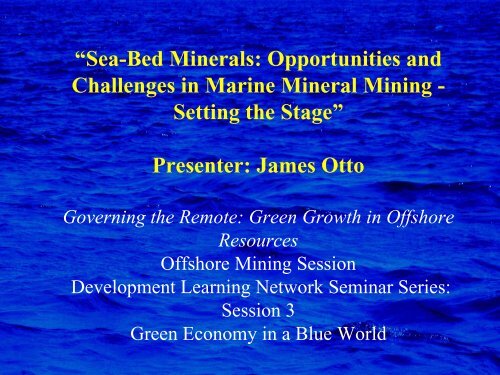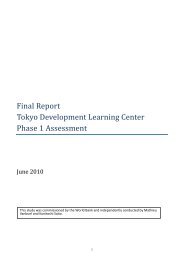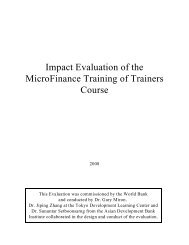Mr. James Otto - Tokyo Development Learning Center
Mr. James Otto - Tokyo Development Learning Center
Mr. James Otto - Tokyo Development Learning Center
Create successful ePaper yourself
Turn your PDF publications into a flip-book with our unique Google optimized e-Paper software.
“Sea-Bed Minerals: Opportunities and<br />
Challenges in Marine Mineral Mining -<br />
Setting the Stage”<br />
Presenter: <strong>James</strong> <strong>Otto</strong><br />
Governing the Remote: Green Growth in Offshore<br />
Resources<br />
Offshore Mining Session<br />
<strong>Development</strong> <strong>Learning</strong> Network Seminar Series:<br />
Session 3<br />
Green Economy in a Blue World
Marine Minerals – Structure of Talk<br />
Topics:<br />
• Marine minerals resource base<br />
• Jurisdictional and boundary issues<br />
• Activities in developing marine minerals<br />
• What needs to be regulated and how?<br />
• Fiscal and economic issues<br />
• What the future holds
Marine Minerals – A Diverse Resource Base<br />
Many Pacific nations have both:<br />
near-shore minerals, deep-sea minerals<br />
National minerals policy, regulatory framework and fiscal<br />
approach need to address the appropriate marine mineral<br />
resources; these resources differ from country-to-country
Marine Minerals – Near-Shore & Continental Shelf<br />
• Sand, gravel (dredging for beach sand replacement, construction)<br />
• Coral (jewellery, landfill, construction …)<br />
• Tin and gold placers<br />
• Black sands (titanium minerals)<br />
• Silica sands (glass, electronics)<br />
• Diamonds (Indonesia, Namibia …)<br />
• Phosphorite (mainly 30 degrees N & S of equator, New Zealand)<br />
• Lime (originally from shells)<br />
• Sulphur (Gulf of Mexico)<br />
• Oil & gas<br />
• Deposits that extend under land and water but are accessed via land<br />
• Salt (evaporative or extractive)<br />
• Water (desalinization or underwater freshwater springs)<br />
many are now commercially mined
Marine Minerals – Deep-Sea<br />
Poly-metallic nodules:<br />
• occur mainly at a depth of 4,000-5,500m in<br />
international waters<br />
• main minerals of value; cobalt, copper, iron, lead,<br />
manganese, nickel, and zinc<br />
• International Law of the Sea may apply (Regulations<br />
for Prospecting and Exploration of Poly-metallic<br />
Nodules have been issued)<br />
• some Pacific nations have this resource<br />
no current large-scale commercial operations
Co-Mn crusts:<br />
Marine Minerals – Deep-Sea<br />
• occur on sides of seamounts & plateaus<br />
• mainly occur up to the mid-latitudes but especially rich in<br />
the central equatorial Pacific Region<br />
• depth dependent (400 to 4,000 m); richest at 800 to<br />
2,500m<br />
• main minerals of value: cobalt, titanium, cerium, nickel<br />
and zirconium<br />
• many occurrences in the EEZs of Pacific nations<br />
• for occurrences in international waters: Law of the Sea<br />
Regulations on Prospecting and Exploration for Cobalt-Rich<br />
Crusts are still being prepared<br />
no current large-scale commercial operations
Marine Minerals – Deep-Sea<br />
Hydrothermal vents:<br />
• underwater metal-rich hot springs (known as black & white<br />
smokers)<br />
• occur where the earth’s crust has been disturbed allowing water to<br />
migrate into the earth, accumulate minerals and then vent on the<br />
ocean floor (such as volcanoes, rim of fire tectonic plate edges)<br />
• main minerals of value: copper, iron, zinc, silver, gold<br />
• occur in both Pacific nation EEZs and international waters<br />
• for minerals in international waters: Law of the Sea Regulations<br />
for Prospecting and Exploration of Poly-metallic Sulphides apply<br />
no current large-scale commercial operations; some<br />
pending operations such as in PNG and Solomon Islands
Marine Minerals – Deep-Sea<br />
Methane hydrates: occur in cold & deep waters<br />
no current large-scale commercial operations<br />
Oil & gas<br />
many examples of current production
Marine Minerals – Jurisdictional Issues<br />
International waters – Law of the Sea or “rogue” nations<br />
Exclusive Economic Zone – 200 miles …<br />
• National laws apply<br />
• Many disputed areas: some are now being measured<br />
• Disputed border zones: amicable solution, joint<br />
development areas are possible (Thailand & Malaysia; Timor-<br />
Leste & Australia; …)<br />
Division of responsibilities within a country<br />
• Central versus provincial governments; where does<br />
provincial jurisdiction end (at the waterline or other<br />
boundary?)<br />
• Which ministry shall take the lead?<br />
• Which ministries will be involved in regulation?
Marine Minerals – Activities to Regulate<br />
• Exploration<br />
• Mining<br />
• Beneficiation (concentrating the mineral in order to<br />
lower transport costs or increase its value, can be offshore<br />
or land-based)<br />
• Smelting & refining or other type of value addition
Regulatory system: what needs to be regulated and how?<br />
Mining Law – granting the rights to explore and mine<br />
• Use the general “land-based” mining law? Solomon Islands<br />
& PNG<br />
• Add special marine minerals sections and regulations in the<br />
general mining law?<br />
• Create a special marine minerals law?<br />
• Negotiate special agreements on an ad hoc basis?<br />
• Optimal approach: may depend on institutional capacity,<br />
budget<br />
Marine mining law topics that may differ from land-oriented regulation:<br />
tendering, open entry, licensing, area size, licence duration, content of<br />
reports, who gets consulted, approval of mine plans, reclamation,<br />
surveying & boundary markers, role of Geological Survey, closed areas,<br />
stakeholder engagement, … there are substantial differences
Regulatory system: what needs to be regulated and how?<br />
Environment Law<br />
• Ecological impacts not well understood for deep-sea operations,<br />
near-shore operations can have large impacts<br />
• Size of area affected depends on the deposit and the means of<br />
recovery and processing - generally likely to be highly localized<br />
with limited permanent infrastructure<br />
• Are special regulations required?<br />
• Issues to be addressed: Environmental Impact Assessment;<br />
Social Impact Assessment; near-shore versus deeper waters;<br />
pollution standards; discharge permits; plume control …)<br />
• Social impacts - probably no mining towns as such, especially if<br />
offshore floating facilities are used - impacts may be felt<br />
indirectly through impacts on coastal economy / displaced marine<br />
livelihoods - low jobs impact due to highly capital intensive<br />
operations (rather like offshore oil drilling)
Regulatory system: what needs to be regulated and how?<br />
• Maritime act (permitting; lighting; discharge; shipping<br />
lanes; inspection; seaworthiness of vessels & platforms;<br />
…)<br />
• Health and safety act (permitting; inspections; hours<br />
…)<br />
• Fisheries Act (subsurface structures; proximity of<br />
fishing vessels to operations; closed zones; …)<br />
• Protected areas acts (such as marine parks)<br />
A holistic approach is required
Marine Minerals – Fiscal & Economic<br />
Fiscal<br />
• Should special incentives be offered to a pioneer industry (can<br />
incentives make marine minerals more competitive?)<br />
• Special depreciation rates?<br />
• Customs: import and export inspections and duty (live aboard?)<br />
• Income tax on expatriates working in the EEZ<br />
• Area based rents & fees<br />
• Royalties on mixed-metal concentrates & ores (such as from<br />
smokers)<br />
• Property taxes<br />
• Distribution system challenges (example: regimes where<br />
royalty distribution is tied to provinces or landholders)
Economic<br />
Marine Minerals – Fiscal & Economic<br />
• Mandatory economic linkages?<br />
- Supply chain (preference for local goods and services)<br />
- Training and employment of nationals (limits on expatriates)<br />
- Local downstream processing<br />
• Economic Scale for deep-sea mining: will be large scale compared to<br />
other enterprises and may result in potentially transformative Foreign Direct<br />
Investment, export, Gross Domestic Product and public revenue impacts for<br />
small island states<br />
• Resource curse: Will additional fiscal revenues be used wisely in a<br />
sustainable manner? Will the investment in this sector impact other sectors<br />
of the economy? Examples of land-based mining have illustrated that large<br />
projects can result in problems: such as in Nauru and Bougainville
Marine Minerals – Looking Forward<br />
• Near-shore: a current and immediate issue in many Pacific nations<br />
(especially sand and coral dredging)<br />
• Deep-sea: except for oil and gas the economics and technology are<br />
unproven; land-based resources are still plentiful but are nonrenewable;<br />
increased level of activity spurred on by high commodity<br />
prices and technological advances; the need to get the regulatory and<br />
fiscal system prepared<br />
• Time to develop marine minerals regulatory system: about 2 years<br />
to draft regulatory changes, receive stakeholder inputs, and place<br />
before the parliament (a holistic approach is needed)<br />
This presentation is intended to set the stage for the next two<br />
presenters who will expand on these subjects. They will also<br />
address a major regional marine minerals project being<br />
coordinated by SPA-SOPAC.
















